
The Union House, also known as the John Bower House, is a small, mostly Gothic Revival house in downtown Orangeville, Illinois, United States. The house, the first brick home in Orangeville, was built in 1849 by village founder John Bower. It was purchased by Samuel Hutchins in 1885 and it remained in the Hutchins family until 1951. The house blends elements of Greek and Gothic Revival architecture and is the only example of Gothic Revival found in the village of Orangeville. The house was added to the U.S. National Register of Historic Places in 2000.

The William Morris Davis House is a National Historic Landmark on 17 Francis Avenue in Cambridge, Massachusetts. An architecturally undistinguished Queen Anne-era house, probably built in the 1890s, it is notable as the home of William Morris Davis between 1898 and 1916. Davis (1850-1934) was a professor of geology at Harvard University, and an influential figure in the development of meteorology and geomorphology as scientific disciplines. His textbook Elementary Meteorology was a standard of that field for many years. The house was declared a National Historic Landmark in 1976.

The Scales Mound Historic District is a historic district in the small Illinois village of Scales Mound. The district encompasses the entire corporate limit of the village and has more than 200 properties within its boundaries. The district was added to the U.S. National Register of Historic Places in 1990.

The Louis C. and Amelia L. Schmidt House is a historic building located in a residential neighborhood on the east side of Davenport, Iowa, United States. It was listed on the National Register of Historic Places in 2007.
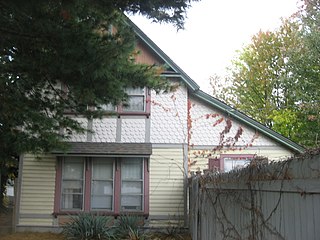
The Reef House is a historic house located at 411 S. Poplar St. in Carbondale, Illinois. William A. Reef built the house for his family circa 1892. The Queen Anne-style cottage may have been designed by local carpenter A. M. Etherton, though records of its designer do not exist. The house features fishscale shingle siding on its second floor and clapboard siding on its first; the clapboard siding is adorned with stickwork. A gable on the south side of the house features half-timbering at its top. The house's front porch features turned posts, a typical Queen Anne feature. The house is one of the only Queen Anne homes in Carbondale which largely retains its original condition.

The Charles Brainerd House is a historic house located at 420 E. Main St. in Grafton, Illinois. The house was built in 1885 for Charles Corrington Brainerd, the superintendent of the Grafton Stone and Transportation Company. Architect William Embley designed the house in the Queen Anne style. The house has an asymmetrical plan which includes an angled front entrance and a multi-component roof with several gables and a pyramid above the entrance. Three of the gable ends feature coved cornices and decorative shingles and wood pieces. The front porch is supported by turned posts and features quarter round brackets and a spindlework cornice on its roof. The house was added to the National Register of Historic Places on February 5, 1998.

The Frederick B. Carter Jr. House is a historic house located at 1024 Judson Avenue in Evanston, Illinois. Architect Walter Burley Griffin designed the Prairie School house, which was built in 1910. The house is an early example of Griffin's attempts to develop a style independent of his mentor, Frank Lloyd Wright. The exterior of the house is made of brick and stucco with wooden half-timbering and trim. The house's form is distinguished by several projecting and receding masses. Its roof includes a large gable in front and overhanging eaves, both over the gable and on the flat section of roof to the side.

The William S. Bailey House is a historic house located at 100 South Campbell Street in Macomb, Illinois. The house was built in 1887 for William S. Bailey, a prominent local businessman who built several of the buildings on Macomb's town square. The house has a Queen Anne style design with Eastlake details; it is one of the best-preserved Queen Anne homes in Macomb. The 2+1⁄2-story house has a hipped roof with cross gables; the gable ends are decorated with spindlework cresting. Three brick chimneys with patterned masonry provide ventilation for the house's fireplaces and kitchen stove. The front porch features a spindlework railing and decorative trim along the roof and the entry pediment.

The Lucinda Hunter House is a historic house located at 101 East 8th Street in Vermont, Illinois, United States. The house was built in the early 1870s for Lucinda Hunter, the mother of village postmaster John Hiram Hunter. The house is an example of the Gable Front type of the Side Hall plan, a vernacular style popular for much of the 19th century. The Side Hall plan as exhibited in the house features two rooms on each story connected by a hall to the side; the Gable Front type reflects its roof form, a gable roof with a front-facing gable. Elements of several popular architectural styles decorate the house, such as the Greek Revival entrance, Italianate arched windows, and Gothic pointed arches on the porch.
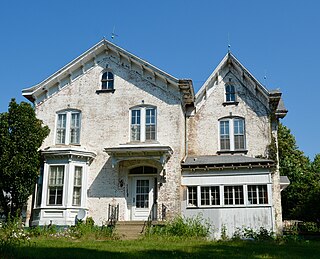
The Edward Hamer House is a historic house located at 200 West 2nd Street in Vermont, Illinois. Businessman Edward Hamer had the house built for himself and his wife in 1871. The house has an Italianate design and is one of two Italianate homes in Vermont with a front-facing gable. Both of the house's gables are steep and feature decorative brackets along the cornice. The front entrance is topped by a decorative hood with braces and paired brackets. A three-sided bay window with matching brackets projects from the first floor next to the entrance; the house's remaining windows are tall, narrow, and topped by segmental arches.

The Robert Dilworth House is a historic house located at 606 East Fifth Street in Vermont, Illinois. The house was built in 1872 for Robert Dilworth, a local banker, politician, and pharmacist. The house was designed in the Italianate style, a nationally popular architectural style at the time. The main entrance is situated behind a full-length front porch supported by beveled columns; the front door itself has a decorative wooden surround and is topped by a transom. The house's windows are tall, narrow, and topped by arches, as is common in Italianate architecture. The gable roof has a front-facing gable adorned by decorative brackets along its eaves.

The William Franklin and Rebecca Durell House is a historic house located at 408 West 5th Street in Vermont, Illinois. Local businessman William Franklin Durell and his wife Rebecca had the house built in 1872; at the time, West 5th Street was a desirable neighborhood for prominent Vermont residents known as "The Lane". The couple's house is designed in the Italianate style. Decorative porches project from the house at the front entrance and on the east side, and the house's windows are tall and narrow with segmental arched tops. The house's low hip roof features a cornice with paired brackets. A Victorian-inspired carriage house with a cross gable plan and a cupola is also part of the property.
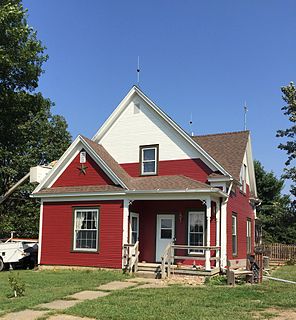
The Charles Emmor McCormick House is a historic house located at 712 West 3rd Street in Vermont, Illinois. Contractor Daniel S. Frazier built the house in 1900 for farmer Charles Emmor McCormick and his family. The house has a Gable Front plan, a common inexpensive home plan at the time which was characterized by its front-facing gable. The Gable Front plan allowed for a variety of floor plans and decorative styles; the McCormick house has an irregular plan and is two rooms wide on its main story. The house's ornamentation is inspired by the Queen Anne style and includes a smaller gable in front of the main front gable and a front porch supported by turned columns and adorned with spindle-work.

The J.H. Riekenberg House is a historic residence located in Boone, Iowa, United States. Born in Schleswig, Germany, Riekenberg emigrated to the United States in 1867, and became a successful businessman and civic leader in Boone. He had Charles E. Edwins, a local architect, design this house, and local contractor J.J. Thoren built it in 1898. The 2½-story, frame Queen Anne house features an asymmetrical plan, steeply pitched roof, a wrap-around front porch, a variety of wall surface texture, an octagonal corner tower, and Palladian elements in the gable ends. The house was listed on the National Register of Historic Places in 1987.

The John H. Shoemake House, also known as the Shoemake-Muhl House, is a historic residence located in Oskaloosa, Iowa, United States. A native of Tennessee, Shoemake was a local businessman and local politician who settled in Mahaska County from Illinois in 1848. He had this two-story brick residence built in 1852 at a time when most houses in the area were built of wood. It follows the I-house plan, and it features Federal style elements that are found in the stepped gables, the massing of chimneys in pairs, and its overall symmetry. It was built with a flat roof, which was not unusual in Oskaloosa at the time. The gable roof was added sometime after 1869. The house was listed on the National Register of Historic Places in 1984.
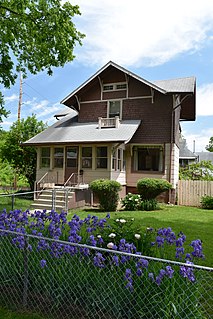
The William B. Hayes House is a historic building located in Des Moines, Iowa, United States. The house is significant for its being one of the best examples in Des Moines of the Swiss chalet style subtype of the Stick Style. It was built in 1886 as a single-family dwelling by local developer Lowry W. Goode. This 1½-story frame structure on a brick foundation features a gable-end facade that is intersected by side gables, and wide eaves that are supported by wood braces. The northern side gable extends over an enclosed front porch. The house was listed on the National Register of Historic Places in 1996.
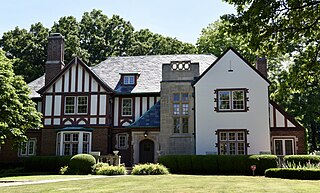
The Dr. Charles Compton House is a historic house located at 1303 South Wiggins Avenue in the Oak Knolls neighborhood of Springfield, Illinois. The house was built in 1926 for Dr. Charles Wentworth Compton, a local surgeon and the founder of local political group the Wentworth Republicans. Springfield architects Helmle and Helmle designed the Tudor Revival house, which was one of their many works in Oak Knolls. The house's front facade features a variety of materials and textures. The main entrance has its own roof and neighbors a stone tower with a parapet. The front of the house has a projecting gable on either side of the door; one gable is stucco with brick-edged windows, while the other matches the rest of the front facade, with brick on the first floor and stucco half-timbering on the second. The original slate roof of the house is broken by two brick chimneys.

The John and Ann Williams House, at 205 Church St. in Stevensville, Montana, United States, was built in 1907. It was listed on the National Register of Historic Places in 1991.

The Christian F. Weinrich House is a historic house at 217 Opdyke Street in Chester, Illinois. The house was built circa 1873 by Christian F. Weinrich, a local merchant who lived in the house with his family until his death in 1913. Weinrich designed the house using elements of the Folk Victorian and Gothic Revival styles. The house's Folk Victorian features include its gable front plan with a side gable and the stickwork on the front-facing gable. While many of its Gothic Revival elements are also Folk Victorian elements, such as its steep roof and decorative wooden porch, its intersecting gables are a characteristic feature of the style.
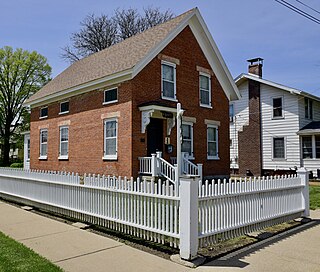
The Dr. William Burns House is a historic house at 201 N. Franklin Avenue in Polo, Illinois. The house was built in 1854 for Dr. William Burns, Polo's first medical doctor and one of its most prominent early citizens. After working as a traveling doctor, Burns began practicing in nearby Buffalo Grove in 1848; like much of Buffalo Grove, he moved to Polo after an Illinois Central Railroad station opened there. Burns' house, the first brick house in the city, had a vernacular gable front plan; such homes were popular at the time, especially in newly formed railroad towns. Burns lived in the house until he moved to a larger one in 1868; he went on to serve as Polo's mayor, a town council and school board member, and a financial benefactor of the city.






















